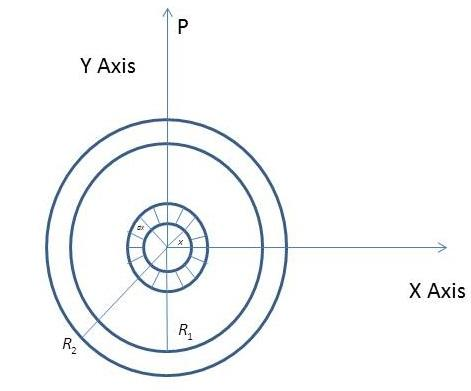Question
Question: An annular disk has an inner and outer radius \({R_1}\) and \({R_2}\) respectively. A charge is unif...
An annular disk has an inner and outer radius R1 and R2 respectively. A charge is uniformly distributed. Surface charge density is σ. Find the electric field at any point distant y along the axis of the disk.
A) 2εoσ
B) 2εo(R2−R1)σy
C) 2εoσy[R12+y21−R22+y21]
D) 2εoσylogR1+yR2+y
Solution
Here we have to imagine a hypothetical ring of radius X and thickness dx, the hypothetical ring is inside the ring. We have to find the electric field of the hypothetical ring first and then we have to integrate the electric field to get the electric field of the real ring on the point p on the y-axis.
Formula used:
The formula for finding out the coefficient of performance is given below.
E=(x2+y2)3/2Kqy
Here,
E= Electric field
K= Proportionality constant (9×109 N m2/C2)
q= Charge
x= Distance in the direction of the x axis.
y= Distance in the direction of y axis
The formula for charge on the hypothetical ring is
dq = σ × 2πx;
σ= Surface charge density.
x = Radius of the hypothetical ring
2πx = Circumference of the hypothetical ring.
Complete step by step answer:
Step 1: Look at the below picture. Here, apart from the Big ring whose radius is R1 and R2. We have to draw a hypothetical ring whose radius is x and thickness is dx. We have to find the charge on the hypothetical ring.

The charge on the hypothetical ring is
dq = σ× 2πx;
Now, we know the electric field due to a ring, which is
E=(x2+y2)3/2Kqy
So, for a small charge dq, the equation becomes,
E=(x2+y2)3/2Kdqy
Put the value of dq in the above equation
E=(x2+y2)3/2K(σ×2πx).y
Step 2: Calculating the total electric field of the ring by integrating the equation.
E=4πεo(x2+y2)3/2(σ×2πx).y; (Here k =4πεo1=9×109)
After solving the above equation we get
E=2εo(x2+y2)3/2σ.x.y
Now, we integrate the equation from R1toR2
E=2εoσy∫R1R2(x2+y2)3/2xdx
Let x2+y2=p2;
Now differentiate x2 w.r.t x and p2w.r.t p, we get
x2+y2=p2; …. (dxdxn=nxn−1)
Differentiate each variable,
dxdx2+dxdy2=dpdp2; ….(dxdx2=2x); (dx2=2xdx)
Heredxdy2=0; because of a different variable in the numerator,
2xdx+0=2pdp;
2xdx=2pdp;
Here, we have established a relation between xdx and pdp.
Now, put x2+y2=p2in the given below equation,
E=2εoσy∫R1R2(x2+y2)3/2xdx
Write the above equation in terms of p,
E=2εoσy∫R1R2(p2)3/2pdp
solving the above equation,
E=2εoσy∫R1R2p(3)pdp
Simplify the above equation
E=2εoσy∫R1R2p(2)1dp ….(∫p(−n)dp=(−n)+1p(−n)+1)
Solving integration,
E=2εoσy[(−2)+1p(−2)+1]R1R2
Simplify further,
E=2εoσy[−p−1]R1R2
Put the value of p i.e. p =(−x2+y2)−1
E=2εoσy[(−x2+y2)−1]R1R2
E=2εoσy[(−x2+y2)1]R1R2
Put the upper limit (R2) in place of x and then put the lower limit (R1) in place of x. Add the two terms together.
E=2εoσy[−(R22+y2)1+(R12+y2)1]
The electric field at any point distant y along the axis of the disk is E=2εoσy[−(R22+y2)1+(R12+y2)1]. Hence option (C) is correct.
Note:
The equation E=2εoσy∫R1R2(x2+y2)3/2xdx is of complex nature. Kindly be careful while doing the integration. Here we have to solve complicated integration as well as complicated variables, to make it simple put the complicated variable into a single variable and then solve for the integration.
